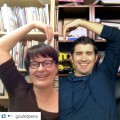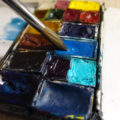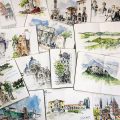Last week I spent a lot of time thinking about thumbnails as a result of the first lesson of my current online course – Watercolour On Location.
I rarely use thumbnails in my own work when I am out urban sketching but I often use them when I teach as they are the best way to explain my thought process.
I like to work spontaneously and I want my sketches to be the first response to a scene, so I’m often keen to just start. I have developed a number of techniques (such as starting with the focus and starting with the darks) which enable me to work in a way that encourages making decisions on the fly. I love this way of sketching as it’s all about discovery and risk-taking – I’m not afraid of producing an unsuccessful sketch. But if I was more concerned about producing consistently good results, I would always do thumbnails.
I think your attitude towards thumbnails is related to how you define sketching. Many of my urban sketching friend’s ‘sketches’ are more like quick plein air paintings and I totally understand the need for a thumbnail if you are going to spend an hour or more on a painting. For me, ‘sketching’ is my initial response, so often the thumbnail IS the sketch.

In the first lesson of Watercolour On Location I explained a number of different thumbnails to explore different aspects of designing a sketch – story, position, important edges, big shapes and values. It was really interesting to hear the various ways in which people struggled with doing a series of thumbnails as a planning stage for their work. I’ve been aware of some of these issues for years, but it was great to be reminded of them.
Thumbnails should be small, working drawings focusing on the big picture issues but with enough accuracy to be a useful guide for the main sketch. The struggle for many people is that they are not confident with their own drawing/observational skills to be able to do a working drawing easily. They either:
- start drawing without thinking about the important elements (edges and shapes) and end up spending a lot of time producing a smallish sketch full of details.
- or else they rush, resulting in a thumbnail which is often too inaccurate to be useful.
Another issue is that doing the thumbnails can take away the time and the energy that people had for the main sketch.
Can you relate to these issues?
I truly believe that being able to do good thumbnails is a specific skill that needs to be developed. And so, I’m planning some bonus material inside the new course to address this.

In recent weeks as part of the extra work I’m doing for the course, I have been doing a lot more thumbnails in my general sketching.
My discoveries
- If I use thumbnails for the first (and second) sketch of the day, I’m reminded of the important issues and get into a rhythm of resolving them. I’m then able to think through these issues in my head without actually doing a thumbnail for the remaining sketches that to do that day.
- Sometimes it’s fun just to do the thumbnails study. I am finding that I then don’t need to do a main sketch as I have already adequately recorded the place.
- I’m really liking the graphic of thumbnails in my pages – either as a small element on the side of a page, or making a pleasing page of just thumbnails.
I have a lot more things which I could share but I’m leaving them for my video within the course.
Watercolour On Location has been my favourite course to run – I’ve been loving all the great work done and the amazing questions and comments each week. It’s been so wonderful to get beyond the ‘what brush are you using’ type of questions to the really important issues of composition, design, value and story-telling. My creative brain is getting a real workout and I know that when the dust settles it will do good things for my own work. If you are doing the course – thank you for making it so special!!
And BTW, I’m closing enrollment to the course in a few days time so I can fully focus on working through the lessons with this incredible group. The course will not be available until the second half of 2020.
However, right now, I would really love to hear from you:
- If you are a beginner, what do you struggle with when it comes to thumbnails?
- If you are a more experienced sketcher – how often do you do thumbnails? When do you decide to do them and how long do they take (thumbnail vs the main sketch)?
I can’t wait to read your comments!








7 Comments
Hi Liz!
I agree with you about the spontaneity of sketching without a thumbnail. That is the reason I love to just sketch, it’s freedom, and not afraid to make mistakes. However, for a more important piece I definitely plan it out with a thumbnail and notes, colors and medium. Hoping next year to take your watercolor on location!
Hi Liz,
Until now ( before watercolour on location course) I had always sketched without a thumbnail. The only time I do thumbnails is when we are travelling by train and I don’t have much time to sketch but just quickly capture my observation of the beautiful countryside of Salzkammergut in Austria.
I find myself thinking too much after taking the course because earlier I would just sketch without putting in too much thought and not worry about mistakes . But your course has surely made me realise the importance of understanding values before going ahead painting with colours! Sketching architecture has always been a huge stumbling block for me but with thumbnails it’s surely getting better ?!
Hi Liz,
Prior to Watercolour on Location I never did any thumbnails, because they were too daunting. Now I discovered what a big help they are!
When I did my first few thumbnails I discovered that I find it hard to identify the important edges, or seeing shapes for that matter. Also when I do a thumbnail I relax and that makes me more focused on what I’m doing.
My plan is to definitely develop that skill, :-)))
Hi Liz,
I don’t normally do thumbnails. I am doing Watercolor on Location and can now see how they can help. I have been sketching for sometime. So find that I am set in my ways, which is jump in and hope for the best! I did go out sketching yesterday and did three sketches. One I did a thumbnail sketch. I need to remember to refer it more when I paint. I found myself referring to it after I painted the sketch. I believe they are a great tool. For me it will be a matter of retraining how I work.
I’ve been doing more thumbnails recently and I have often found that they are better ( or more satisfying to me) than the “main” sketch that I go on to do. The latter often feels more static, laboured.
I think the preliminary sketch is done in a more relaxed way … and is more spontaneous as a result.
I’ve done Foundations, watercolour and edges and still find the concepts difficult, but watercolour on location is bringing things together much more….but I still have a long way to go. Exploring a scene through thumbnails and implementing some of the ideas about selection, values and composition etc is moving me on. These little drawings are the “smaller steps” that I need to make progress.
Many thanks, Liz
I usually do a fast and loose value thumbnail as a warmup in workshops and for plein air painting if I’m going to spend a long time on the piece. In the WOL class, I learned more about my subject with each type of thumbnail, but was disappointed with my final sketch because it felt static and dull compared to the energy I had for doing my thumbnails. On the other hand, I think the thumbnail exploration process would be great for developing a careful image for a white line woodcut or block print.
I usually don’t do thumbnails, I am one of those who put too many details into the small sketch and then I get frustrated because they don’t fit! At the same time I loose interest and almost get bored with the object or I become too fussy. Thinking too much and planning beforehand makes my sketches into paintings and that’s not my goal. I guess I simply can’t do the same thing twice. It is either a real sketch with no worries about success or it is just thumbnails in their own right. What I have come to like a lot in the course WOL are the tonal studies with pens, but they are normally not followed by a watercolour sketch.
NEWSLETTER
Subscribe for first notification of workshop + online classes and more.